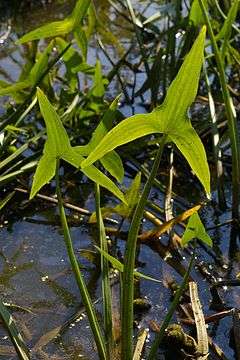Sagittaria sagittifolia
| arrowhead | |
|---|---|
 | |
| Scientific classification | |
| Kingdom: | Plantae |
| (unranked): | Angiosperms |
| (unranked): | Monocots |
| Order: | Alismatales |
| Family: | Alismataceae |
| Genus: | Sagittaria |
| Species: | S. sagittifolia |
| Binomial name | |
| Sagittaria sagittifolia L. | |
| Synonyms[1] | |
| |
Sagittaria sagittifolia (also called arrowhead due to the shape of its leaves) is a flowering plant in the family Alismataceae, native to wetlands most of Europe from Ireland and Portugal to Finland and Bulgaria, as and in Russia, Ukraine, Siberia, Japan, Turkey, China, Australia, Vietnam and the Caucasus. It is also cultivated as a food crop in some other countries. In Britain it is the only native Sagittaria.[2][3]

Sagittaria sagittifolia is a herbaceous perennial plant, growing in water from 10–50 cm deep. The leaves above water are arrowhead-shaped, the leaf blade 15–25 cm long and 10–22 cm broad, on a long petiole holding the leaf up to 45 cm above water level. The plant also has narrow linear submerged leaves, up to 80 cm long and 2 cm broad. The flowers are 2-2.5 cm broad, with three small sepals and three white petals, and numerous purple stamens.
Cultivation and uses
The round tuber is edible. In Japan, it is known as Omodaka,オモダカ, 沢瀉, 澤瀉,面高 , and its tuber is eaten particularly on the Chinese New Year. It tastes bland, with a starchy texture, similar to a potato but somewhat crunchier, even when cooked. In Vietnam, the plant's young petiole leaves and rhizomes are used for soups.[4]
Remnants of Sagittaria sagittifolia have been found in the Paleolithic/Mesolithic site of Całowanie in Poland.[5]
Seven new ent-rosane diterpenoids and a new labdane diterpene were recently (2006) purified from the Chinese medicinal plant, Sagittaria sagittifolia (Alismaceae). Four of these compounds (Sagittine A–D) exhibited antibacterial activity against Streptococcus mutans and Actinomyces naeslundii while another (Sagittine E) was only active against A. naeslundii (MIC = 62.5 μg ml–1). Recently, the same group identified five new diterpenoids from Sagittaria pygmaea. None of these displayed activity against A. actinomycetemcomitans, while four of the others were active against A. viscosus and three were active against S. mutans, of which 18-ß-D-3',6'-diacetoxyglucopyranosyl-ent-kaur-16-ene was the most active.[6]
As a weed
Sagittaria sagittifolia can be weedy or invasive according to the USDA, Animal and Plant Health Inspection Service (APHIS), Plant Protection and Quarantine (PPQ). It also appears on state noxious weed lists for 46 states.[7]
See also
References
- ↑ The Plant List
- ↑ Kew World Checklist of Selected Plant Families, Sagittaria sagittifolia
- ↑ IUCN Red List of Threatened Plant Species, Sagittaria sagittifolia
- ↑ Tanaka, Yoshitaka; Van Ke, Nguyen (2007). Edible Wild Plants of Vietnam: The Bountiful Garden. Thailand: Orchid Press. p. 17. ISBN 9745240893.
- ↑ Kubiak-Martens, Lucyna (1996). "Evidence for possible use of plant foods in Palaeolithic and Mesolithic diet from the site of Całowanie in the central part of the Polish Plain". Vegetation History and Archaeobotany. 5 (1-2): 33–38. doi:10.1007/BF00189433.
- ↑ B.Parimala Devi et al. / Journal of Pharmacy Research 2009, 2(11),1669-1675 http://jpronline.info/article/view/906/708
- ↑ USDA Plants Profile
External links
